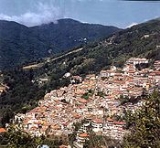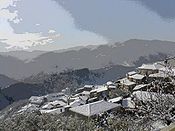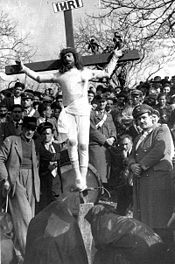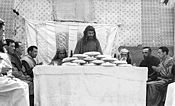
San Pietro Apostolo
Encyclopedia


Comune
In Italy, the comune is the basic administrative division, and may be properly approximated in casual speech by the English word township or municipality.-Importance and function:...
and town
Town
A town is a human settlement larger than a village but smaller than a city. The size a settlement must be in order to be called a "town" varies considerably in different parts of the world, so that, for example, many American "small towns" seem to British people to be no more than villages, while...
in the province of Catanzaro in the Calabria
Calabria
Calabria , in antiquity known as Bruttium, is a region in southern Italy, south of Naples, located at the "toe" of the Italian Peninsula. The capital city of Calabria is Catanzaro....
region of Italy
Italy
Italy , officially the Italian Republic languages]] under the European Charter for Regional or Minority Languages. In each of these, Italy's official name is as follows:;;;;;;;;), is a unitary parliamentary republic in South-Central Europe. To the north it borders France, Switzerland, Austria and...
. It is located about 9.5 miles northwest of Catanzaro, the provincial capital.
Perched on a hillside, it occupies 11.51 square kilometers, and had a population of 1,925 inhabitants in 2001. It is surrounded by the villages of Decollatura
Decollatura
Decollatura is a comune and town in the province of Catanzaro in the Calabria region of Italy.It is famous for being the birthplace of the Italian poet Michele Pane -Notes and references:* Imperio Assisi et al., Decollatura e Motta S...
, Gimigliano
Gimigliano
Gimigliano is a comune and town is the province of Catanzaro in the Calabria region of Italy....
, Miglierina
Miglierina
Miglierina is a comune and town in the province of Catanzaro in the Calabria region of Italy....
, Serrastretta
Serrastretta
Serrastretta is a town and comune in the province of Catanzaro in the Calabria region of southern Italy.-Geography:The town is bordered by Amato, Decollatura, Feroleto Antico, Lamezia Terme, Miglierina, Pianopoli, Platania and San Pietro Apostolo....
and Tiriolo
Tiriolo
Tiriolo is a town and comune in the province of Catanzaro in the Calabria region of southern Italy.-Geography:The town is bordered by Catanzaro, Gimigliano, Marcellinara, Miglierina, San Pietro Apostolo and Settingiano....
. The largest nearby town is Nicastro
Nicastro
Nicastro was a small town in the province of Catanzaro, in the Calabria region of southern Italy.Since 1968 it constitutes, together with Sambiase and Sant'Eufemia Lamezia, the city of Lamezia Terme.- Geography :...
, which has since become part of the larger comune of Lamezia Terme
Lamezia Terme
Lamezia Terme, commonly named Lamezia, is an Italian city of 71,287 inhabitants in the province of Catanzaro in the Calabria region.-Geography:...
.
The parish church is that of San Pietro. Other churches in S. Pietro are Madonna di Carmelo and Madonna della Lettera.
Historical Notes
The best available knowledge regarding the history of San Pietro Apostolo indicates that it was founded by peasants who fled from Motta Santa Lucia after the earthquakeEarthquake
An earthquake is the result of a sudden release of energy in the Earth's crust that creates seismic waves. The seismicity, seismism or seismic activity of an area refers to the frequency, type and size of earthquakes experienced over a period of time...
of 1638. Moving to the interior, they asked asylum of Prince Cigala of Tiriolo, who allowed them to settle in the area which is today known as "Colla Pagliara", in exchange for the payment of a modest head tax. They subsequently moved to a lower area which was more sheltered from the wind. It is said that a small statue of the apostle St. Peter was erected in these regions, and that the village was named accordingly. San Pietro Apostolo was administered by its neighbor Tiriolo until the end of the 18th century when it obtained its autonomy under law No. 14 of 19 January 1807. It was elevated to the status of a comune with the name of 'San Pietro a Tiriolo' and placed under the jurisdiction of what was then called Calabria Ulteriore, which consisted of the current provinces of Catanzaro, Crotone
Crotone
Crotone is a city and comune in Calabria, southern Italy, on the Ionian Sea. Founded circa 710 BC as the Achaean colony of Croton , it was known as Cotrone from the Middle Ages until 1928, when its name was changed to the current one. In 1994 it became the capital of the newly established...
, Reggio Calabria
Reggio Calabria
Reggio di Calabria , commonly known as Reggio Calabria or Reggio, is the biggest city and the most populated comune of Calabria, southern Italy, and is the capital of the Province of Reggio Calabria and seat of the Council of Calabrian government.Reggio is located on the "toe" of the Italian...
and Vibo Valentia
Vibo Valentia
Vibo Valentia is a city and comune in the Calabria region of southern Italy, near the Tyrrhenian Sea. It is the capital of the province of Vibo Valentia, and is an agricultural, commercial and tourist center . There are also several large manufacturing industries, including the tuna district of...
. On 4 May 1811 the comune was given the name of San Pietro Apostolo, attesting its separation from Tiriolo which remained, however, the administrative seat. Law No. 360 of 1 May 1816 transferred the village of San Pietro Apostolo with its 1992 inhabitants from the administration of Tiriolo to that of Gimigliano
Gimigliano
Gimigliano is a comune and town is the province of Catanzaro in the Calabria region of Italy....
, and from the province of Calabria Ultra to the new province of Calabria Ultra Seconda (Catanzaro).
The most famous episode in the history of San Pietro Apostolo is the stopover of Giuseppe Garibaldi
Giuseppe Garibaldi
Giuseppe Garibaldi was an Italian military and political figure. In his twenties, he joined the Carbonari Italian patriot revolutionaries, and fled Italy after a failed insurrection. Garibaldi took part in the War of the Farrapos and the Uruguayan Civil War leading the Italian Legion, and...
on the night of 28 August 1860. The leader of the Expedition of the Thousand
Expedition of the Thousand
The Expedition of the Thousand was a military campaign led by the revolutionary general Giuseppe Garibaldi in 1860. A force of volunteers defeated the Kingdom of the Two Sicilies, leading to its dissolution and annexation by the Kingdom of Sardinia, an important step in the creation of a newly...
, coming from Maida, was a most welcome guest of the Garibaldi supporter Guglielmo Tomaini (already condemned to death by the Bourbons for having been one of the supporters of the movements of Maida and Filadelfia) where, with his closest collaborators, he took note of the situation and planned the forthcoming operations that would have opened the roads to Naples
Naples
Naples is a city in Southern Italy, situated on the country's west coast by the Gulf of Naples. Lying between two notable volcanic regions, Mount Vesuvius and the Phlegraean Fields, it is the capital of the region of Campania and of the province of Naples...
; on the same night Francisco Stocco, with only a few men, induced the surrender of 10,000 men commanded by General Ghio and encamped at Soveria Mannelli, by cleverly having ignited numerous fires placed very visibly on the surrounding heights. Garibaldi's visit is commemorated by two tablets placed on walls of the Tomaini Palace in 1887 and 1961. There are two noble houses in the historical center of San Pietro: the mentioned Tomaini Palace and the Mazza Palace. These were repeatedly targeted by bandits and still preserve their defense systems, among which are two holes through which hot oil was cast out onto attackers who tried to break down the doors.
In the course of the 17th century, an important role was played in the economy of San Pietro by the harvesting and processing of gorse
Gorse
Gorse, furze, furse or whin is a genus of about 20 plant species of thorny evergreen shrubs in the subfamily Faboideae of the pea family Fabaceae, native to western Europe and northwest Africa, with the majority of species in Iberia.Gorse is closely related to the brooms, and like them, has green...
(it. 'ginestra'), a fibrous plant that was softened in the Amato river below the village. This provided a fiber which was used by local spinners for the production of cloth. Silkworm breeding was also very common - the worms were fed on white mulberry leaves which were present in the area. The silk thus produced was almost all locally processed and for the most part marketed in Catanzaro, Nicastro and also in the neighboring town of Serrastretta.
In the early 1920s, the village was divided into several wards: Fundacu (on the national road); Vrugale (from the national road to Calvary Hill; Valla (from Calvary Hill to the school building); Savuci (Independence street); Timpariellu (from the school building to the Mazza butcher shop); Piazzetta (the area around Santino Mazza's store); Cerasiellu (named for a local bend in the road); Magazinu (Marconi Square), Chianu e Mazza (the Mazza palace); Granduani (Venezia street); Un Zeta (the tract from the upper fountain to Piazza Roma); Chiazza (Piazza Roma); and Mulijiti (today's Gramsci Street).
Traditions and folklore


The feast of San Pietro is celebrated on 29 June. The feast of Madonna di Carmelo begins on 14 July and lasts for three days, and that of Madonna della Lettera is celebrated on the last Sunday of September, during which the final torch procession has particular significance.

